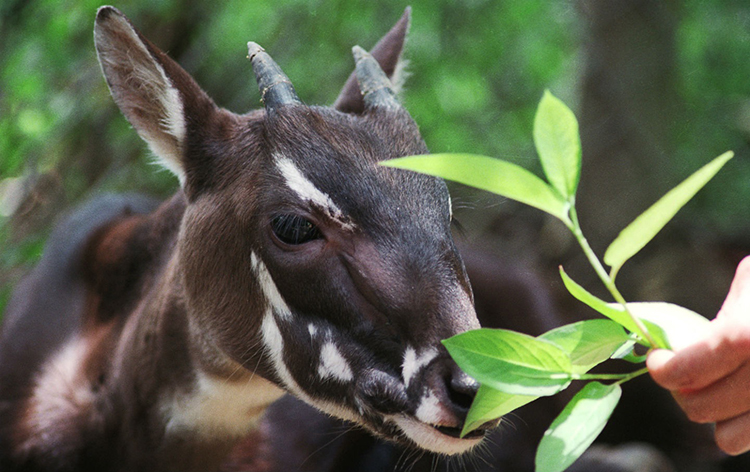Hey guys! This week’s species is another one I have never heard of, but its nickname intrigued me! Find out what it is in the fun fact section 🐴📯🌈! This week’s blog is a little short given there is not much known about the species… also keep reading to find out about this hehe. Enjoy!
(Critically) Endangered Species of the Week: Saola
Pseudoryx nghetinhensis

The saola (sow-la) was discovered in May 1992 during a joint survey carried out by the Ministry of Forestry of Vietnam and WWF in north-central Vietnam. The team found a skull with unusual long, straight horns in a hunter’s home and knew it was something extraordinary. The find proved to be the first large mammal new to science in more than 50 years and one of the most spectacular zoological discoveries of the 20th century.
Nearly 3 decades since discovery, little is still known about the saola. None exist in captivity and this rarely-seen mammal is already critically endangered. Scientists have categorically documented saola in the wild on only four occasions to date.
Saola are recognized by two parallel horns with sharp ends, which can reach 20 inches in length and are found on both males and females. Meaning “spindle horns” in Vietnamese, they are a cousin of cattle but resemble an antelope.
Where Do They Live?
The Saola occurs only in the Annamite Mountains, along the border of Vietnam and Laos. It has one of the smallest ranges of any large mammal.
The region is a subtropical/tropical moist environment which is characterized by evergreen or mixed evergreen and deciduous woodlands, and the species seems to prefer edge zones of the forests. Saola are presumed to reside in mountain forests during the wet seasons and move down to the lowlands in winter.

Why Are They Important?
With its unusually long horns and white markings on the face, the saola is a strong symbol for biodiversity in Lao and Vietnam.
They are also important to conserve and pay attention to because the actual size of the remaining population is unknown. Its rarity, distinctiveness and vulnerability make it one of the greatest priorities for conservation in the region. The current population is thought to be a few hundred at a maximum and possibly only a few dozen at a minimum.

Fun Facts:
- Saola are often called the Asian unicorn 🐴📯🌈.
- Saola have striking white markings on the face and large maxillary glands on the muzzle, which could be used to mark territory or attract mates.
- Saola remains an enigma into the 21st century due to being rarely seen in the wild.
- It resembles an antelope, but DNA has proven they are more closely related to cow species—which is why they were designated Pseudoryx, or “false antelope.”
- All known captive saola have died, leading to the belief that this species cannot live in captivity.

Why Are They Endangered?
HABITAT LOSS
As forests disappear under the chainsaw to make way for agriculture, plantations and infrastructure, saola are being squeezed into smaller spaces. The added pressure from rapid and large-scale infrastructure in the region is also fragmenting saola habitat. Conservationists are concerned that this is allowing hunters easy access to the once untouched forest of the saola and may reduce genetic diversity in the future.
HUNTING
Saola are often caught in snares set in the forest for wild boar, sambar or muntjac deer. Local villagers set some snares for subsistence use and crop protection. Recent increases in lowland people hunting to supply the illegal trade in wildlife has led to a massive increase in hunting, driven by traditional medicine demand in China and restaurant and food markets in Vietnam and Laos.

What Is Being Done?
IN 2006, the IUCN Species Survival Commission’s Asian Wild Cattle Specialist Group created the Saola Working Group to protect the saola and their habitat. WWF has been involved with the protection of the saola since its discovery, focused on strengthening and establishing protected areas as well as research, community-based forest management, and strengthening law enforcement. Management of Vu Quang Nature Reserve where the saola was discovered has improved in recent years.
Two new adjacent saola reserves have been established in Thua-Thien Hue and Quang Nam provinces. The WWF has been involved in the setting up and management of protected areas and continues to work on projects in the region.


Sources:
https://www.worldwildlife.org/species/saola
https://www.savethesaola.org/what-is-a-saola/
https://www.thoughtco.com/profile-of-the-endangered-saola-1181994
See ya!

